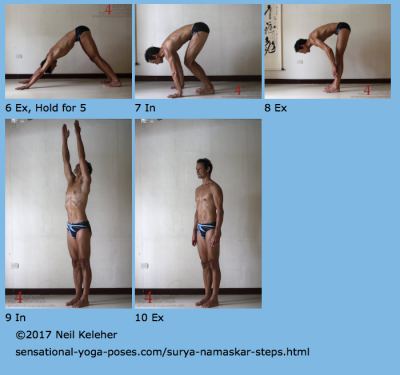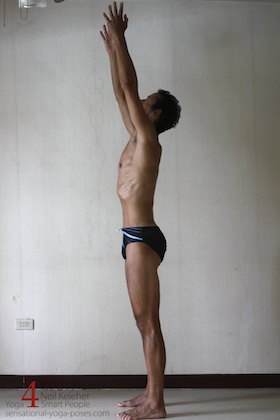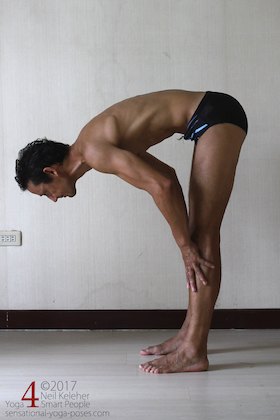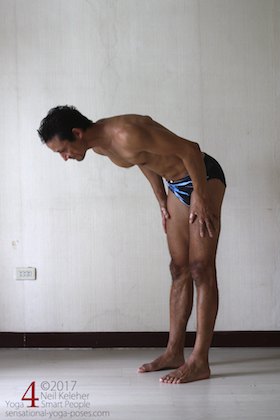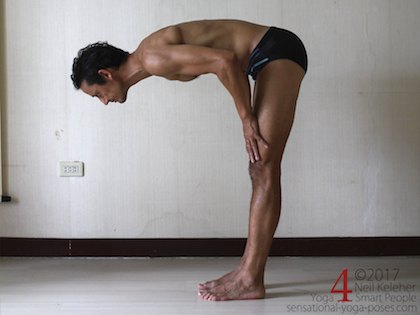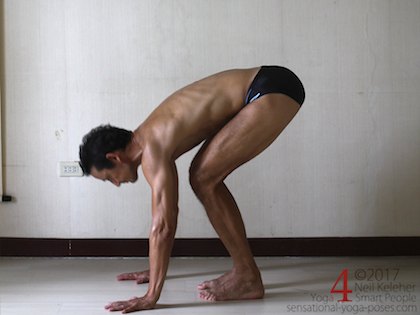Surya Namaskar Arm Lift
When you are ready, at the beginning of an inhale start to lift your arms. Try to match the movement of your arms to your inhale so that your arms reach the top and stop just as your inhale does. Then as you exhale lower your arms. Match the speed of your arms to your exhale so that they arrive at your sides just as your exhale ends.
Surya Namaskar Forward Bend
As another example, starting with your arms up, as you exhale, bend forwards.
You can finish with your hands on your legs, or if you can reach it, the floor. Try to finish your forward bend at the same time as your exhale finishes. Then as you inhale, stand up and reach your arms up as you do so.
Here again, match the movement of your arms to your breath so that they finish together.
What if You Have Difficulty Breathing Slowly While Moving?
Now, what if you can’t breath slowly and smoothly, or find yourself rushing the movement so that it ends as your breath ends? I’d suggest forget the breath and focus on moving slowly and smoothly.
Or another option is to break-down your movements further.
The Surya Namaskar Arm Lift Broken Down Further
As an example, to lift your arms:
- Inhale your arms to shoulder height (either forwards or out to the sides).
- Exhale while keeping your arms there.
- Then inhale your arms all the way up.
So now, instead of lifting your arms on one inhale, you use two inhales with an exhale inbetween.
Surya Namaskar Forward Bend Broken Down Further
If bending forwards from here:
- exhale and bend forwards to a position half way to your maximum forward bend.
- Stop here and take an inhale.
- Then exhale the rest of the way down.
So now, instead of a single exhale to bend forwards you use two exhales separated by an inhale during which you hold the position you are in.
Surya Namaskar and Shifting Weight to Your Hands
Now lets say that you are bent forwards. Bending your knees if you have to, place your palms on the floor and shift your weight forwards. This is ideally done with a single inhale but again, if you have trouble with breathing slowly, inhale your hands to the floor, then exhale, then on the next inhale shift your weight forwards.
To return to your feet, reverse the process:
- Exhale and shift your weight back.
- Then stop, for an inhale,
- then exhale your hands off of the floor
(and straighten your knees if they were bent.)
Review the Steps so Far
We’re actually going over the steps of surya namaskar, so if you want, go back and review what we’ve done so far.
You'll actually be better off reviewing the movements now so that they stick a bit easier. .
Repeat the movements a few times to get a feel for them. If you focus on just a few movements at a time, say lifting and lowering your arms, then you may find that you can focus on enjoying the movements themselves. And you may find that you remember them rather easily.
But even if you forget something, not to worry, we’ll finish with some tips on how to self check your surya namaskar steps.
I'll continue to divide the movements into two parts. If you can have no problem breathing slowly and smoothly then do each movement with a single inhale or exhale.
Skipping a Few Steps
(We'll come back to them in a bit!)
So back to bending forwards with your weight forwards towards your hands. From here you ideally step back and lower down into a push up position called chaturanga dandasana with a single exhale. However, instead of that pose, you can make it easier on yourself by stepping back to downward facing dog instead.
Stepping Back to Downward Facing Dog
To break the movement down:
- Step both feet back while keeping your shoulders over your wrists.
Do this with an exhale.
- Then stop for an inhale.
- Then on the next exhale, push your torso backwards so that your hips move up.
Thus you end up in downward dog.
If breath work isn't a problem, then simply step your feet back for the first half of your exhale then push your hips back and up for the second half of your exhale.
Reverse the steps to return to the weighted hand position as follows:
- Inhale your shoulders forwards, over your hands,
- hold for an exhale,
- then inhale your feet forwards.
Returning to Standing
From here (bent forwards with weight towards your hands):
- Exhale and shift weight back onto your feet,
- hold for an inhale,
- then exhale your knees straight and your hands off of the floor if you need to.
Then inhale half way up, take an exhale, then inhale the rest of the way up.
Exhale your hands to half way, inhale for a rest, then exhale your hands all the way down.
Inserting Plank and Upward Dog
Now for the some of the steps of Surya Namaskar A that we skipped.
Lets say that you aren't comfortable with the push up position called Chaturanga Dandasana. You can substitute plank instead. We'll use plank position twice in this modified portion of surya namaskar
- Start with weight on your hands.
- With an exhale, step your feet back to plank.
- Inhale into upward dog.
Next:
- From upward dog, exhale to plank.
- Hold for an inhale.
- Then exhale to downward dog.
From here, you can return to the "hands on the floor position" or return to standing.
Adding Chaturanga Dandasana
Say you are comfortable with chaturanga dandasana (or have worked at getting more comfortable with it, you can do the following (still using plank as in intermediary position).
- Starting with weight on hands,
- Inhale your feet back to plank with an exhale.
- Hold for an inhale then on your next exhale, bend your elbows into chaturanga dandasana.
Go straight to upward dog on an inhale or:
- From chaturanga
- inhale back to plank, hold for a breath
- Then exhale to upward dog.
Note that straightening your arms from chaturanga to go into plank and then dropping your hips into upward dog is actually a bit more work for the arms than moving straight from chaturanga into upward facing dog.
From here, either go straight back to downward dog (with an exhale) or via plank pose (exhale plank, hold for an inhale, then exhale to downward dog.)
If It's Complicated, Focus on Little Bits
So normally a surya namaskar a has 10 steps. With doubled breaths, it's a bit more than that. An inhale is now an inhale plus an extra exhale and an inhale. An exhale is now an exhale plus an extra inhale and exhale. So instead of 10 steps we now have 30. Or there abouts. It depends on how many planks you add in. At any rate, a simple sequence of 10 movements is now a little bit more complex.
So what do you do next? Practice the little bits. Each of the above mini-sequences should be short enough that you can practice them in isolation, getting better at doing them without having to think about them which means you can then focus on the quality of your movements. That can include controlling your breath as you do the movements.
Then you can focus on reducing the number of steps to 10.
10 movements is only a little bit difficult to remember. And to make it easier to remember them, or at least easier to self check, one of the things that you can remember is that inhales happen with odd numbered movements (i.e. 1-lift your arms) while exhales happen with even numbered movements (i.e 2-bend forwards).
So, the steps of the uncomplicated Surya Namaskar A:

1 In
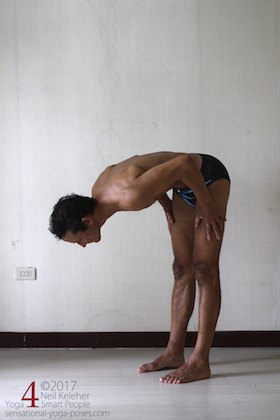
2 Ex
- Movement 1 is lifting the arms while inhaling.
- Movement 2 is bending forwards while exhaling.
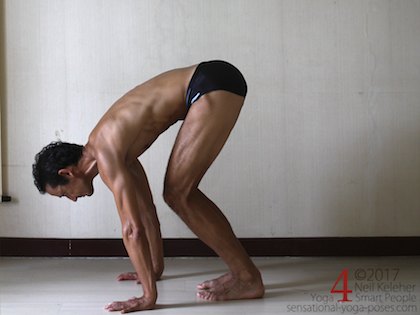
3 In
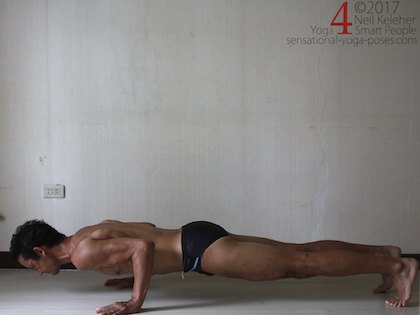
4 Ex
- Movement 3 is shifting your weight towards your hands with an inhale.
- Movement 4 is stepping back into chaturanga dandasana with an exhale.
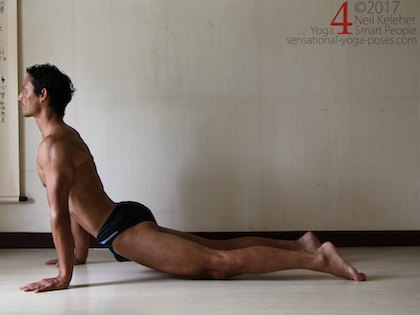
5 In
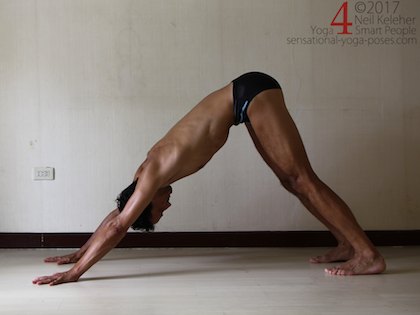
6 Ex, Hold for 5
- Movement 5 is upward dog, done with an inhale.
- Movement 6 is downward dog, done with an exhale.
Normally downward dog is held for 5 inhales and exhales.

7 In
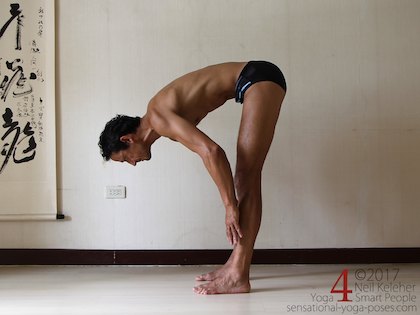
8 Ex
- for movement 7, inhale your feet forwards, with your weight towards your hands.
- For movement 8, bend forwards with an exhale.

9 In

10 Ex
- Movement 9 is standing and lifting your arms.
- Movement 10 is lowering your arms by your sides.
Published: 2017 09 01
Updated: 2022 10 28
